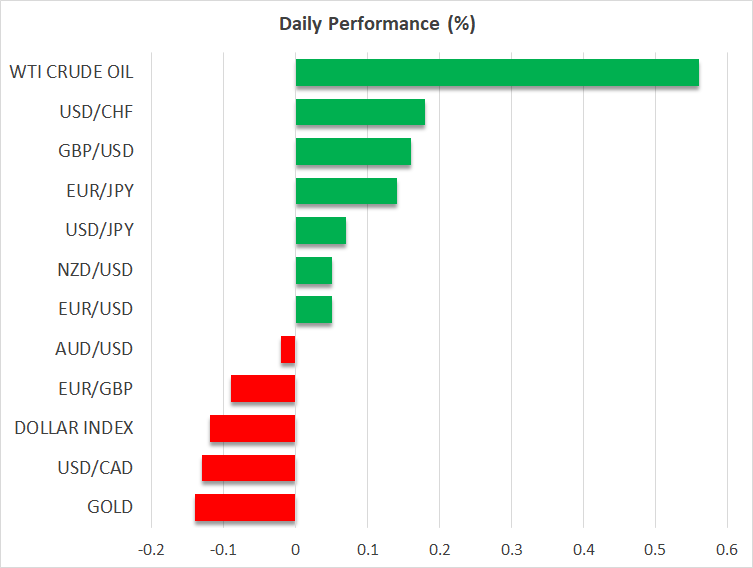- Dollar slides, but uptrend remains intact
- Kiwi gains on China news and New Zealand jobs data
- Aussie also higher as RBA maintains tightening bias
- Wall Street trades in the green, gold rebounds

US dollar corrects lower as traders secure profit
The US dollar pulled back against all its major counterparts on Tuesday, with the main gainers being the kiwi, the aussie, the pound and the yen in that order.
With no fundamental catalyst to drive the greenback lower, its pullback may have been the result of profit taking following the rally that was sparked by the astounding US jobs data on Friday and was further fueled on Monday by the strong ISM non-manufacturing survey.
Comments by Fed Chair Powell over the weekend may have also helped the world’s reserve currency as the Fed Chief said that the Committee can be “prudent” in deciding when to start lowering borrowing costs as a strong economy allows them time to build confidence that inflation is under control.
His view was echoed by Minneapolis Fed President Kashkari and Cleveland President Mester, with the former saying that they are “not done yet” with inflation, and the latter noting that although the door to rate cuts could open if the US economy performs as she expects, it is too early to decide on the timing.
Although Mester and Kashkari’s comments did not further boost the dollar, this whole blend of data and remarks resulted in a notable repricing with regards to the Fed’s future course of action. From being certain about a March rate cut, investors are now assigning only a 20% probability to such a move, with the total number of basis points worth of rate reductions by the end of the year coming down to 120.
This suggests that the question on investors’ minds now is not whether the world’s largest economy will avoid a recession, but whether it will reaccelerate. And with other major economies falling behind the US, the US dollar may rebound and continue its prevailing uptrend if data and Fed officials continue pouring cold water on the market’s implied rate path.
Kiwi and aussie take the most advantage of the dollar’s retreat
The kiwi was the main gainer yesterday, initially receiving support from renewed speculation that China is ready to adopt more stimulus measures to support the market. The risk-linked currency added to its gains after New Zealand’s better-than-expected employment report.
Following the data, investors reduced the total bps worth of RBNZ rate reductions anticipated by the end of the year to 64 from 90, while from being more than fully priced in, a July cut has now a 50% chance of happening.
The aussie secured second place, aided by the RBA’s decision to maintain its tightening bias and by headlines regarding more stimulus in China. The fact that the market expects the RBA to lower interest rates by less than 50bps this year can be interpreted at first glance as a supportive factor for the aussie.
However, with not much room for upside adjustment, at a time when the Fed’s implied path is being revised higher day by day, monetary policy may not prove to be a game changer for this currency, especially if the optimism surrounding China evaporates again.
Wall Street gains as dollar slides, gold also benefits
On Wall Street, all three of its main indices closed yesterday’s session in positive territory, perhaps aided by the greenback’s retreat. That said, even if the dollar rebounds and resumes its prevailing uptrend, the stock market is unlikely to suffer much. Any setback could provide renewed buying opportunities.
With more than half of the S&P 500 companies having already reported earnings and more than 80% of them beating estimates, the aggregate earnings of the index are expected to have risen 8.1%. This combined with upbeat US macroeconomic numbers may allow investors to keep adding to their risk exposure, even if the Fed delays rate cuts.
Gold also benefited from the dollar’s slide and the pullback in Treasury yields, still holding above the key support zone of $2015. That said, a rebound in the dollar may result in a break below that barrier, especially if hopes of a possible lengthy ceasefire in the Middle East translate into reduced demand for safe havens.

